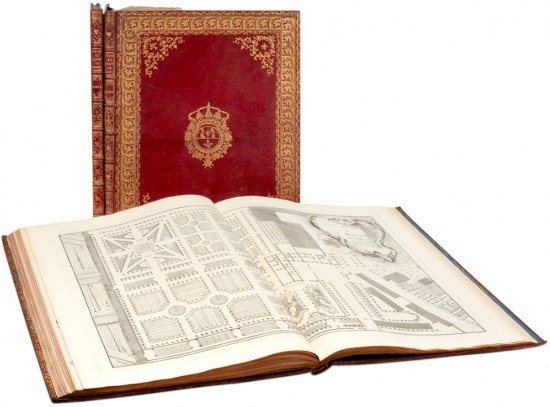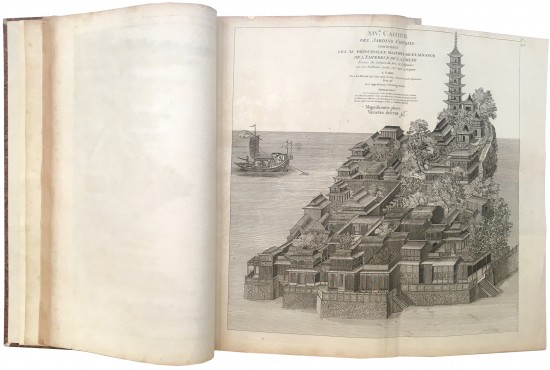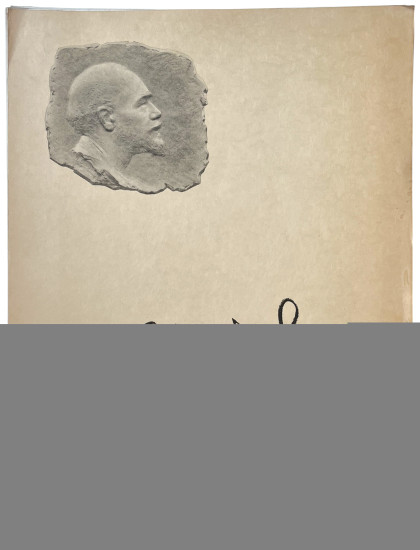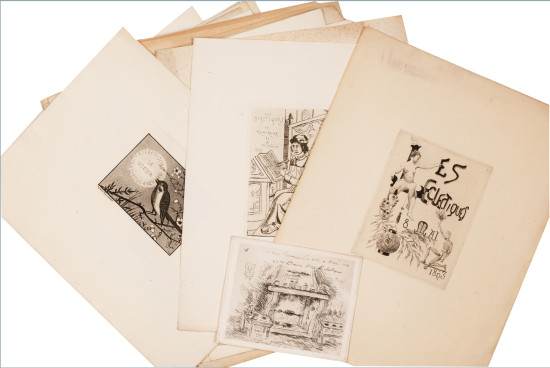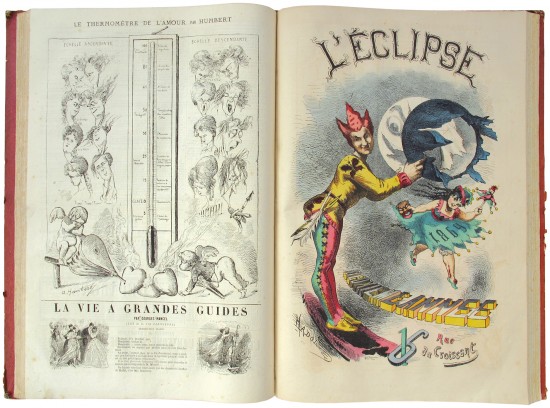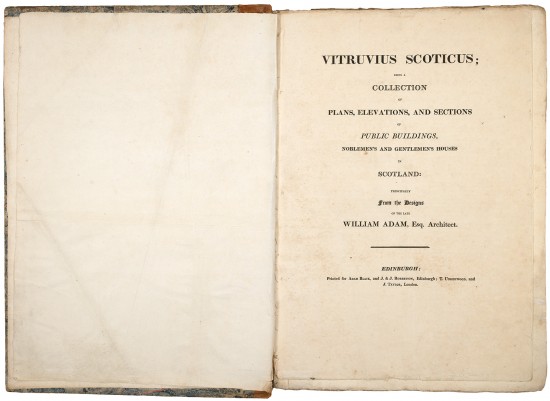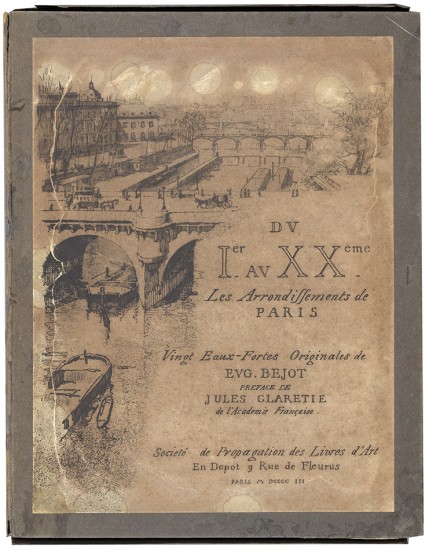Recueil des Plans, Elevations et Coupes ... des Châteaux, Jardins et Dependances Que le Roy de Pologne Occupe en Lorraine [Together with:] Suite des Plans, Elevations et Coupes [And:] Plans et elevations de la Place Royale de Nancy et des Autres Edifices qui l'Environnent
Here De Corny, Emmanuel Léopold
Paris. Se Vend à Paris Chez François. 1750 c.–1753
The rare first edition - a beautiful copy in contemporary red morocco with the arms of Stanislas Leczinski for whom the book was produced - of one of the greatest and most beautiful 18th century books on gardens and architecture.
The volumes were composed, designed and engraved by Emmanuel Héré de Corny (1705 - 1763), a French architect, and Jean Charles François (1717 - 1769), a French engraver from Nancy. Héré was the chief architect to the twice-deposed Polish King, Stanislas Leczinski (1677 - 1766), who received the Duchys of Bar and Lorraine in the Treaty of Vienna. Héré devoted his entire professional career (1736 - 1763) to Stanislas and was almost single-handed in the design of the plans and direction of the works.
The first two volumes, published in 1750 (or 1751), illustrate designs for the chateaux, parks, and garden pavilions Héré executed for Stanislas: Lunéville, Chanteheux, Malgrange, Commercy and Eineville. Also included are designs for churches (Saint-Remy and Bonsecours), the Hôpital Saint-Julien at Nancy, the altar of the chapel at Lunéville, that at Saint-Remy and so on. According to Millard: 'A first edition of 125 copies was produced ... ' and that the information concerning the publication ' ... is contained in the 1761 expense accounts for Stanislaw'.
Stanislas’ gardens at Lunéville included ‘Le Rocher’, an extraordinary project of water-powered automatism designed by Héré and achieved with the skill of engineer and clock-maker François Richard. ‘Le Rocher’ included musicians, shepherds, a miller, a drunkard and so on, all performing actions suited to their rôles. Stanislas’ guests, either strolling or boating, became active participants in the mise en scène of the tableau vivant. Stanislas’ marvellous automata and their movements were described by Héré himself ‘dont les movements sont si bien omits qu’ils ne paraissent point d’être l’effet de l’art.'
The third volume, published three years later, is devoted entirely to illustrate the plans for the Place Royale de Nancy. In addition to plans and views of the three interconnected spaces in Nancy, the volume contains the designs of the structures adorning the processional route, including the Hotel de Ville, the Hotel Consulate, the Bourse de Commerce, and the Palace of the Military Government, as well as the triumphal arches, statues, fountains, and wrought iron grilles that ornamented the spaces. The ensemble is one of the major works of urban design of the eighteenth century.
'Stanislaw's gardens and parks were a major influence on French picturesque design, for they were visited by many French and European guests. Voltaire and the Comte de Girardin (the creator of Ermenonville), among others ... and both Marc Antoine Laugier and Sir William Chambers described Stanislaw's gardens ... '. (see Millard pg. 205).
Copies of all three volumes in contemporary bindings are scarce but are known in original boards, calf (with or without arms) and, as here, in red morocco. As per the catalogue 'De Vitruve à Ledoux', which traces four known copies in red morocco, all feature small variations in tooling or variants in the combination of arms. Of these, one features the arms of the Dauphin (the son of Louis XV and father of Louis XVI, Louis XVIII and Charles X who pre-deceased his father and never ascended to the throne), two feature the arms of Stanislas and one further example, the present copy, features the arms of Stanislas combined with those of Nancy.
'Les beaux exemplaires en reliure aux armes sont rares: on connait celui de l'ancienne collection Pouillon [this copy], en maroquin rouge aux armes jumelées de Stanislas et de la ville de Nancy ... celui aux armes du Dauphin fils de Louis XV ainsi que quelques exemplaires reliés en veau aux armes de Stanislas.' (Livres Précieux de XVe au XIXe Siècle, 2010).
'Mon père, vous êtes mieux logé que moi ... '. (Louis XV to Stanislas Leczinski, King of Poland and father of Louis' wife).
'Stanislaw's architecture, executed by Héré, is known for its playful, exuberant character, its suprise effects, theatrical landscapes, and expression of the capricious and exotic taste of its patron ... These luxurious volumes, produced to promote Stanislaw's claims to royalty and his connections with the royal house of France (his daughter was married to Louis XV in 1725), were designed in the manner of royal books of ceremonies, coronations, solemn entries, and funerary rites, by which sovereigns made known the majesty of their reign. The superb quality of the designs and engravings, the ornamentation of the frames, the engraved lettering. and the huge size of the volumes are all in the tradition of productions for the Cabinet du Roi.' (Millard).
With a limitation (according to Millard and the accounts of Stanislas) of 125 copies for the first parts, the work is necessarily rare; equally given the fragmented nature of the publication many copies lack the third part. Copies in contemporary French red morocco are of the utmost rarity.
[Not in RIBA; not in Fowler; Brunet III, 113; Berlin 2511; Millard 78, pp. 200 - 205; Cicognara 4024; for the present copy see lot 72 in the sale 'Architecture: Cent Cinquante Livres Rares des XVIIe, XVIIIe et XIXe siècles', Paris, 1985; see lot 112 in 'De Vitruve à Ledoux', Alde, 2014; see no. 41 in Bernardand Stéphane Clavreuil's catalogue 'Livres Précieux de XVe au XIXe Siècle', 2010; see Alexandre Joly’s ‘Histoire de Lorraine au XVIIIe Siècle: Le Château de Lunéville’, Paris, 1859].
The volumes were composed, designed and engraved by Emmanuel Héré de Corny (1705 - 1763), a French architect, and Jean Charles François (1717 - 1769), a French engraver from Nancy. Héré was the chief architect to the twice-deposed Polish King, Stanislas Leczinski (1677 - 1766), who received the Duchys of Bar and Lorraine in the Treaty of Vienna. Héré devoted his entire professional career (1736 - 1763) to Stanislas and was almost single-handed in the design of the plans and direction of the works.
The first two volumes, published in 1750 (or 1751), illustrate designs for the chateaux, parks, and garden pavilions Héré executed for Stanislas: Lunéville, Chanteheux, Malgrange, Commercy and Eineville. Also included are designs for churches (Saint-Remy and Bonsecours), the Hôpital Saint-Julien at Nancy, the altar of the chapel at Lunéville, that at Saint-Remy and so on. According to Millard: 'A first edition of 125 copies was produced ... ' and that the information concerning the publication ' ... is contained in the 1761 expense accounts for Stanislaw'.
Stanislas’ gardens at Lunéville included ‘Le Rocher’, an extraordinary project of water-powered automatism designed by Héré and achieved with the skill of engineer and clock-maker François Richard. ‘Le Rocher’ included musicians, shepherds, a miller, a drunkard and so on, all performing actions suited to their rôles. Stanislas’ guests, either strolling or boating, became active participants in the mise en scène of the tableau vivant. Stanislas’ marvellous automata and their movements were described by Héré himself ‘dont les movements sont si bien omits qu’ils ne paraissent point d’être l’effet de l’art.'
The third volume, published three years later, is devoted entirely to illustrate the plans for the Place Royale de Nancy. In addition to plans and views of the three interconnected spaces in Nancy, the volume contains the designs of the structures adorning the processional route, including the Hotel de Ville, the Hotel Consulate, the Bourse de Commerce, and the Palace of the Military Government, as well as the triumphal arches, statues, fountains, and wrought iron grilles that ornamented the spaces. The ensemble is one of the major works of urban design of the eighteenth century.
'Stanislaw's gardens and parks were a major influence on French picturesque design, for they were visited by many French and European guests. Voltaire and the Comte de Girardin (the creator of Ermenonville), among others ... and both Marc Antoine Laugier and Sir William Chambers described Stanislaw's gardens ... '. (see Millard pg. 205).
Copies of all three volumes in contemporary bindings are scarce but are known in original boards, calf (with or without arms) and, as here, in red morocco. As per the catalogue 'De Vitruve à Ledoux', which traces four known copies in red morocco, all feature small variations in tooling or variants in the combination of arms. Of these, one features the arms of the Dauphin (the son of Louis XV and father of Louis XVI, Louis XVIII and Charles X who pre-deceased his father and never ascended to the throne), two feature the arms of Stanislas and one further example, the present copy, features the arms of Stanislas combined with those of Nancy.
'Les beaux exemplaires en reliure aux armes sont rares: on connait celui de l'ancienne collection Pouillon [this copy], en maroquin rouge aux armes jumelées de Stanislas et de la ville de Nancy ... celui aux armes du Dauphin fils de Louis XV ainsi que quelques exemplaires reliés en veau aux armes de Stanislas.' (Livres Précieux de XVe au XIXe Siècle, 2010).
'Mon père, vous êtes mieux logé que moi ... '. (Louis XV to Stanislas Leczinski, King of Poland and father of Louis' wife).
'Stanislaw's architecture, executed by Héré, is known for its playful, exuberant character, its suprise effects, theatrical landscapes, and expression of the capricious and exotic taste of its patron ... These luxurious volumes, produced to promote Stanislaw's claims to royalty and his connections with the royal house of France (his daughter was married to Louis XV in 1725), were designed in the manner of royal books of ceremonies, coronations, solemn entries, and funerary rites, by which sovereigns made known the majesty of their reign. The superb quality of the designs and engravings, the ornamentation of the frames, the engraved lettering. and the huge size of the volumes are all in the tradition of productions for the Cabinet du Roi.' (Millard).
With a limitation (according to Millard and the accounts of Stanislas) of 125 copies for the first parts, the work is necessarily rare; equally given the fragmented nature of the publication many copies lack the third part. Copies in contemporary French red morocco are of the utmost rarity.
[Not in RIBA; not in Fowler; Brunet III, 113; Berlin 2511; Millard 78, pp. 200 - 205; Cicognara 4024; for the present copy see lot 72 in the sale 'Architecture: Cent Cinquante Livres Rares des XVIIe, XVIIIe et XIXe siècles', Paris, 1985; see lot 112 in 'De Vitruve à Ledoux', Alde, 2014; see no. 41 in Bernardand Stéphane Clavreuil's catalogue 'Livres Précieux de XVe au XIXe Siècle', 2010; see Alexandre Joly’s ‘Histoire de Lorraine au XVIIIe Siècle: Le Château de Lunéville’, Paris, 1859].
3 vols. Elephant folio. (656 x 490 mm). 83 engraved plates: composed of 3 engraved titles within rich ornamental borders by Lattré, 2 allegorical frontispieces (vols. I and III only) by Jean Charles François after P. Girardet, 2 engraved dedications to the French King (vols. I and III only) and 76 engraved plates, plans, sections and elevations and the two leaves of engraved text in vol. I ('Description du Rocher ... au bas de la Terrasse du Château de Lunevile' with engraved head- and tail-piece, printed recto and verso of a single leaf) and vol. III ('Reflexion sur les Divers Batimens et sur Tous les Ornemens qui les Accompagnent' printed recto only and dated 1751); this copy also with the additional 'Mausoleum' plate added to vol. II. Sheet size: 644 x 462 mm. Full contemporary French crushed red morocco, front and rear boards to each volume with large central vignettes: the arms of Stanislas Leczinski with his bull's head, eagle and cavalier devices with the 'Croix de l'Ordre du Saint-Esprit' and the thistle of Nancy, large decorative corner tools with the repeated devices of Stanislas and the Nancy thistle at centre, all within three elaborate decorative borders with gilt-ruled divisions, turn-ins and board edges with gilt foliate roll tool decor, banded spines with elaborate decorative tooling, titles, volume numbers and the devices in eight compartments with fleurs-de-lys at head and foot, sky blue watered silk doublures and guardleaves, a.e.g.
#48091
